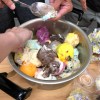“There’s an epidemic going around and we’re here making so…so is it the Nara Era?“
Now that Japanese primary and secondary schools throughout the country are temporarily closed due to the spread of the coronavirus, rumors have become rampant that there’s an excess of milk in the country and dairy farmers are on the verge of losing their businesses. Whether that’s true or not, many people have been trying to help by pitching in to buy more milk than usual. One way to use up vast quantities of milk is by turning it into a dairy product called so (蘇) that was consumed in Japan in ancient times. Consequently, social media accounts in Japan have been abuzz as people document their attempts to reproduce a recipe that’s now in vogue for the first time in 1,000 years.
▼ “I made so! It took about five hours.”
蘇作ってみた〜!!
— よねざわさかな (@E310316) March 8, 2020
5時間ぐらいかかったww pic.twitter.com/1NGtfsA8xU
The origins of so are masked in mystery but it is estimated to have been consumed by the nobility in Japan throughout the Asuka Era (circa 538-710 CE), Nara Era (710-794 CE), and Heian Era (794-1185 CE), a span of time which witnessed everything from the introduction of Buddhism to Japan to the moving of the country’s then-capital to Kyoto. No one quite knows the exact recipe anymore but a basic outline was referenced in the Engishiki, a book completed in 927 that contains a set of governmental regulations and customs:
“Boil down 1 to (an ancient unit of measurement; around 18 liters/4.76 gallons) of milk to get 1 sho (an ancient unit of measurement; around 1.8 liters/0.48 gallons) of so.”
With such limited instructions to go by–basically just heat milk and wait a number of hours before it starts to take solid form–many net users began experimenting with their own variations while cooking such as adding seasonings, simmering in a pan over different levels of heat, stirring in a mix of sugar and salt, and pairing the finished product with honey or black pepper before eating.
▼ “So and more so. The heating conditions between the two were a little bit different. You can tell by the difference in color.”
「蘇」と「蘇」です。
— 平松 サリー(料理研究家・ライター) (@sarisally1) March 8, 2020
加熱条件が少し違います。色の違いがお分かりいただけるだろうか。 pic.twitter.com/HwNtdqWyIc
▼ “From the right are regular so, milk tea so, and café au lait so.”
https://twitter.com/myk_589/status/1236653178843619328It also appears to be quite fluffy when cut:
https://twitter.com/mi_kaor/status/1236691790813466624Finished so is said to taste something like cheese, candy maker Fujiya’s Milky candy, or a slightly less sweet milk cake, but still noticeably different from western dairy products such as yogurt.
Japanese net users reacted to the culinary trend for the most part with intrigue but a few cracked skeptical jokes as well:
“I never imagined that the next big thing after bubble tea would be so…”
“It takes so long to make so. That must be why it was originally a food for nobles.”
“I can’t decide whether the people propagating this so boom are refining our culture to the next level or are just a bunch of idiots.”
“I tasted it at a restaurant in Kyoto once. It had a simple caramel-like flavor.”
“How about using up milk by taking a milk bath instead? You could easily get rid of about three liters that way.”
“蘇が蘇る–So is revived.” [Note: This is a fun bit of linguistic play. The kanji for so (蘇) is the same one used in the root of the verb yomigaeru (蘇る/to be revived).]
If you find yourself with an excess of milk no matter where you are in the world, why not give making so a try? So will we.
Source: J-Cast News via Hachima Kiko
Featured image: Twitter/@sarisally1
● Want to hear about SoraNews24’s latest articles as soon as they’re published? Follow us on Facebook and Twitter!

 How to make so, Japan’s 1,000-year-old dessert recipe that’s back in fashion【SoraKitchen】
How to make so, Japan’s 1,000-year-old dessert recipe that’s back in fashion【SoraKitchen】 Hotel offers guests the chance to experience the 1,000-year-old lifestyle of the Heian Period
Hotel offers guests the chance to experience the 1,000-year-old lifestyle of the Heian Period Japanese beef bowl chain Sukiya’s 2026 Smile Box lucky bag basically pays for itself
Japanese beef bowl chain Sukiya’s 2026 Smile Box lucky bag basically pays for itself We revisited Sweets Paradise after a decade to see if Japan’s dessert buffet still delivers
We revisited Sweets Paradise after a decade to see if Japan’s dessert buffet still delivers The best Starbucks Japan Frappuccinos we want to drink again in 2026
The best Starbucks Japan Frappuccinos we want to drink again in 2026 Village Vanguard’s most expensive Black Lucky Bag sets an ominous tone for 2026
Village Vanguard’s most expensive Black Lucky Bag sets an ominous tone for 2026 Beautiful sightseeing boat is a floating tea ceremony venue in east Japan’s best hot spring town
Beautiful sightseeing boat is a floating tea ceremony venue in east Japan’s best hot spring town How well does canned fruit syrup-flavored drink match up to the real thing?【Taste test】
How well does canned fruit syrup-flavored drink match up to the real thing?【Taste test】 We mixed all 31 flavors of Baskin Robbins ice cream and created a Frankenstein dessert【Video】
We mixed all 31 flavors of Baskin Robbins ice cream and created a Frankenstein dessert【Video】 Pizza Hut Japan’s hot lucky bags are perfect for a New Year’s pizza party
Pizza Hut Japan’s hot lucky bags are perfect for a New Year’s pizza party Asian Juicy: New burgers from McDonald’s Japan pay tribute to a ’90s J-pop music video by Puffy
Asian Juicy: New burgers from McDonald’s Japan pay tribute to a ’90s J-pop music video by Puffy Shiratani Unsuikyo: The breathtaking anime setting where Princess Mononoke was born
Shiratani Unsuikyo: The breathtaking anime setting where Princess Mononoke was born Starbucks Japan ready to get Year of the Horse started with adorable drinkware and plushies【Pics】
Starbucks Japan ready to get Year of the Horse started with adorable drinkware and plushies【Pics】 Hayao Miyazaki says Happy New Year to Studio Ghibli fans with new art for Year of the Horse
Hayao Miyazaki says Happy New Year to Studio Ghibli fans with new art for Year of the Horse 7 great places to see Mt. Fuji from without having to climb it
7 great places to see Mt. Fuji from without having to climb it We found possibly the quietest Japanese-style hotel in Tokyo’s bustling Shinjuku district
We found possibly the quietest Japanese-style hotel in Tokyo’s bustling Shinjuku district Cup Noodle tries an authentic Jiro-style ramen, but something’s not quite right
Cup Noodle tries an authentic Jiro-style ramen, but something’s not quite right Hello Kitty Choco Egg figures are an adorable trip through three periods of Japanese pop culture【Pics】
Hello Kitty Choco Egg figures are an adorable trip through three periods of Japanese pop culture【Pics】 Japan’s oldest largetooth sawfish in captivity back on display in Mie Prefecture
Japan’s oldest largetooth sawfish in captivity back on display in Mie Prefecture Cyberpunk anime meets traditional culture in Ghost in the Shell gold leaf Japanese changing screens
Cyberpunk anime meets traditional culture in Ghost in the Shell gold leaf Japanese changing screens 7-Eleven Japan starts new temporary luggage storage service in over 300 branches
7-Eleven Japan starts new temporary luggage storage service in over 300 branches Disillusionment at Tsukiji’s tourist-target prices led us to a great ramen restaurant in Tokyo
Disillusionment at Tsukiji’s tourist-target prices led us to a great ramen restaurant in Tokyo Starbucks teams up with 166-year-old Kyoto doll maker for Year of the Horse decorations【Photos】
Starbucks teams up with 166-year-old Kyoto doll maker for Year of the Horse decorations【Photos】 Tokyo considering law requiring more trash cans following litter increase in heavily touristed area
Tokyo considering law requiring more trash cans following litter increase in heavily touristed area Tokyo’s Tsukiji sushi neighborhood asks tour groups to stay away for the rest of the month
Tokyo’s Tsukiji sushi neighborhood asks tour groups to stay away for the rest of the month Tokyo event lets you travel back in time, for free, to celebrate 100 years since Showa era start
Tokyo event lets you travel back in time, for free, to celebrate 100 years since Showa era start Sanrio theme park in Japan announces plans to expand into a Sanrio resort
Sanrio theme park in Japan announces plans to expand into a Sanrio resort Japan may add Japanese language proficiency, lifestyle classes to permanent foreign resident requirements
Japan may add Japanese language proficiency, lifestyle classes to permanent foreign resident requirements Stamina-destroying “Paralysis Noodles” are Tokyo’s newest over-the-top ramen innovation
Stamina-destroying “Paralysis Noodles” are Tokyo’s newest over-the-top ramen innovation Survey asks foreign tourists what bothered them in Japan, more than half gave same answer
Survey asks foreign tourists what bothered them in Japan, more than half gave same answer Japan’s human washing machines will go on sale to general public, demos to be held in Tokyo
Japan’s human washing machines will go on sale to general public, demos to be held in Tokyo Japan’s deadliest food claims more victims, but why do people keep eating it for New Year’s?
Japan’s deadliest food claims more victims, but why do people keep eating it for New Year’s? We deeply regret going into this tunnel on our walk in the mountains of Japan
We deeply regret going into this tunnel on our walk in the mountains of Japan Studio Ghibli releases Kodama forest spirits from Princess Mononoke to light up your home
Studio Ghibli releases Kodama forest spirits from Princess Mononoke to light up your home Major Japanese hotel chain says reservations via overseas booking sites may not be valid
Major Japanese hotel chain says reservations via overseas booking sites may not be valid Put sesame oil in your coffee? Japanese maker says it’s the best way to start your day【Taste test】
Put sesame oil in your coffee? Japanese maker says it’s the best way to start your day【Taste test】 No more using real katana for tourism activities, Japan’s National Police Agency says
No more using real katana for tourism activities, Japan’s National Police Agency says Starbucks Japan reveals new sakura drinkware collection, inspired by evening cherry blossoms
Starbucks Japan reveals new sakura drinkware collection, inspired by evening cherry blossoms Updated cherry blossom forecast shows extra-long sakura season for Japan this year
Updated cherry blossom forecast shows extra-long sakura season for Japan this year
Leave a Reply